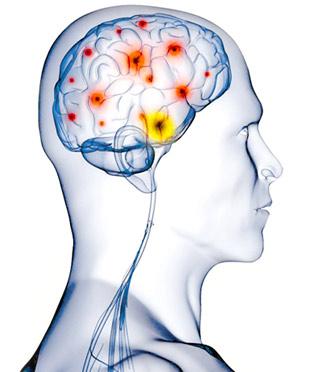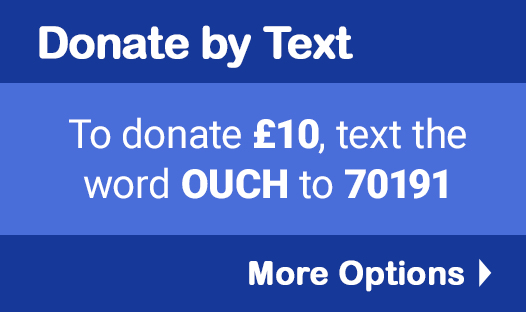Cluster headache (CH) is one of a group of headaches known as trigeminal autonomic cephalalgias (TACs). It is a primary headache (i.e. a headache in its own right, not caused by or a symptom of another illness) that causes severe, debilitating pain. It is generally considered to be one of the most painful medical conditions known, and female sufferers describe the pain as being worse than childbirth. At present, it is a lifelong, incurable condition - though often with periods of remission.
The pain is usually focused around the eye socket/temple, sometimes spreading to other parts of the head, such as the ear, jaw, forehead and neck. The pain tends to occur on one side of the head, although it can switch sides between attacks, and occasionally can change sides during an attack. Individual CH attacks often occur at the same time(s) during the day or night. Each attack typically lasts between 15 minutes and 3 hours (or more), if untreated, and can occur up to 8 times a day. It is common for sufferers to experience an attack within 30-90 minutes of falling asleep - napping during the day is not recommended.
Sufferers usually, but not always, experience one or more of the following symptoms during an attack:
- Reddening and watering of the eye
- A runny or blocked nostril
- Drooping/swollen eyelid
- Constriction of the pupil
- Flushing and facial sweating
- Restlessness/rocking/pacing up and down/extreme agitation
The disease takes two forms, episodic and chronic. In the episodic form, cluster headache attacks tend to start at the same time(s) of each year and occur on a daily basis over a period of weeks or months. They then stop as suddenly as they started, with a remission period of weeks, months or even years, before returning. In the chronic form, sufferers have no significant remission periods.
So, now you know what the nature of the beast is, what are the next steps? The first two things you should look at getting are a prescription of drugs to manage CH, both abortive (painkilling) and preventative and, importantly, a referral to a headache specialist neurologist. Whether you have been diagnosed by a GP or you have diagnosed yourself after doing research on your symptoms and taking our '
Do I have Cluster Headache?' test, you should ask your GP for an urgent referral to a neurologist specialising in headache for an official diagnosis.
The two first-line abortive treatments for cluster headache are subcutaneous (injectable) sumatriptan and high flow oxygen therapy.
There are two types of sumatriptan: Imigran or the generic Sun Pharmaceuticals version. The injections aren’t as scary as they sound - they come with a kit and a pen injector and you don’t even see the needle – you hold the pen to your leg and push a button and the injection is delivered in seconds - you feel a slight sting but this is nothing compared to the pain of a CH attack. Occasionally, GPs will try prescribing the sumatriptan tablets for you - they’re cheaper than the injections – but the tablets simply are not strong enough to deal with the pain of CH and can take up to 30 minutes to start working, if they work at all. The injections can abort an attack in 8 – 10 minutes or less. There are also nasal spray versions of this drug but these take longer to work than the injections and are often ineffective, since many sufferers have a runny or blocked nostril on the affected side.
There are two types of
oxygen therapy, standard high flow oxygen and demand valve oxygen. In Scotland and Northern Ireland, oxygen can only be prescribed by a secondary clinician, i.e., a consultant, so it is more important than ever that you seek a referral to a headache specialist. In England and Wales, your GP can prescribe high flow oxygen: you need to go to the
Downloads section of the OUCH website and download the Home Oxygen Order Form (HOOF). This is part completed ready for a cluster headache sufferer. But before ordering oxygen for you, the GP needs to complete a Home Oxygen Consent Form, and an Individual Home Oxygen Risk Management Form - both these forms will be at the doctor's surgery. Your GP needs to complete the HOOF form online via the oxygen company's online portal, entering your details and the surgery details, as well as the flow rate, cylinder type and oxygen mask as given on the HOOF form in our downloads section. PLEASE NOTE: if the GP has not signed on the HOOF form to say s/he has completed the risk management form, the oxygen supply company will reject the HOOF form. A further important note - if you smoke or anyone in your house smokes, then oxygen will not be supplied for health and safety reasons, as oxygen is highly flammable. Once the HOOF is accepted and received, the oxygen supplier will then contact you directly to arrange delivery. The engineer delivering it will show you how to use it and supply you with masks, as well as a spare cylinder upon request.
Some GPs may say they can’t prescribe oxygen and that it has to be prescribed by a consultant. This is not so in England and Wales, as it is specifically laid down in the Home Oxygen Assessment Service (HOAS) specification that GPs can prescribe oxygen for CH sufferers for pain relief. There is a copy of the HOAS specification in every doctors’ surgery. There is also a new type of oxygen therapy, called ultra high flow oxygen, delivered via a device known as a
demand valve,
similar to the device used for entinox in childbirth and for severe pain. The demand valve HOOF form for this is also available in the
Downloads section of the website and is also part completed for a CH sufferer. Again, the HOC and the IHORM forms have to be completed by the GP and indicated on the HOOF form, and again, the GP will need to submit the form via the oxygen company's online portal. PLEASE NOTE that at present, demand valve oxygen therapy is only available in England and Wales. Call our Advice line to check if it is available in your area of England.
There are also the preventative drugs. The first-line preventative for CH as listed in the British National Formulary (BNF) -the GPs' prescribing bible - is verapamil, one of a group of drugs known as calcium channel blockers. Before starting on verapamil, you need to have an ECG and then further ECG's every two weeks before increasing the dosage. It can take time to build to a level where it starts to work and there can be some side effects such as constipation, severe tiredness and swelling of the hands and feet. There are other preventative drugs for CH, but your neurologist will usually try the verapamil first and then work through the other drugs if you have no success with the verapamil. All preventative drugs are only taken while you are in cluster headache cycle.
So hopefully, you now have some means to deal with the pain of CH but we would still suggest that you ask for referral to a neurologist who specialises in headache disorders. There are many different specialisms in neurology, so it is important to specify a consultant in headache disorders. There are not many in the UK, but a quick call to the OUCH advice line, or an e-mail to adviceline@ouchuk.org will let you know who are the nearest ones to you. In England, under the NHS ‘Choose and Book – Choice at Referral’ scheme, you can ask to be seen by a consultant of your choice, even if they are outside your Integrated Care Board (ICB) area. You do not have to be in a cluster headache cycle for your initial consultation. A consultant neurologist will confirm your diagnosis and give you a treatment plan for your GP to prescribe. A consultant will also see you at regular intervals to monitor your condition and see how you have reacted to acute and preventative medication.
Some sufferers have been refused the sumatriptan injections and/or oxygen, possibly on grounds of cost. Be firm and persistent in asking for what you need. If your GP refuses to prescribe appropriately (or even to refer you to a consultant), you can refer him/her to the BNF, section 4.7.4.3 on cluster headache and also to the NICE (National Institute for Health and Clinical Excellence) guidelines on headache disorders, sections 1.3.26-30, which deal with CH. If your GP still refuses to prescribe or refer you, you can complain to the practice manager at your surgery and, if necessary, take your complaint to the prescriptions manager at your local ICB (should be listed in the phone book or you can Google them).
It’s quite a struggle getting used to dealing with cluster headache and the effects it has on both you and your family. To help your family understand, there is a section of our member’s forum for
supporters of sufferers which they can take part in. We also have a document in our Handouts for Friends and Family section called
‘Pain so Severe’, which gives a description of CH and what life is like for a sufferer, all written in layman’s terms. You will also find a
glossary of some of the commonly used medical terms and written shorthand terms that we use when speaking about cluster headache, e.g., ECH – episodic cluster headache; QS – Queen Square, the address of the National Hospital for Neurology and Neurosurgery in London. Have a good read of the
treatments section on the main OUCH website. Copies of the treatment regimes can be obtained by e-mailing
info@ouchuk.org or
adviceline@ouchuk.org. We also have a very lively Facebook group - you can come and join us here: https://www.facebook.com/groups/OUCHUK/.
Cluster headache impacts on all aspects of a sufferer’s life, and the unpredictable nature of CH has meant that many sufferers have lost their jobs, or at least had to change jobs because of it. CH is now a recognised disability and even episodic sufferers can lodge a claim for PIP (Personal Independence Payment).
OUCH has some advice notes on PIP under the
Get Informed/Your Rights/PIP section
of our website. Again,
The Brain Charity can help with this and you can also contact
Benefits & Work and
Disability Rights UK.
The important thing to remember is, now that you have found this website, you know you are not alone in suffering this disease. There is the OUCH advice Line, 0800 669 6824, or you can e-mail adviceline@ouchuk.org for further advice and help.







